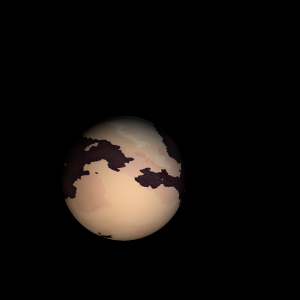|
|
Space Astro
|
Info for exoplanet "Mabsojul"
| Scientific (actual) data |
|---|
| Planet | Kepler-197 c |
| Planet status | Confirmed |
| Planet mass | 0.017 |
| Radius | 0.11 |
| Orbital period | 10.3497 |
| Semi major axis | 0.09 |
| Orbit eccentricity | 0.08 |
| Discovered | 2014 |
| Updated | 2021-02-05 |
| Tconj | 2455010 |
| Impact parameter | 0.22 |
| Publication | Announced on a website |
| Detection type | Primary Transit |
| Alternate names | 2MASS J19405434+5033323 c, K00623.01, KIC 12068975 c, KOI-623 c, KOI-623.01, Kepler-197 A c, WISE J194054.30+503332.4 c |
| Star name | Kepler-197 |
| Right ascension | 295.23° |
| Declination | 50.56° |
| Mag j | 10.814 |
| Mag h | 10.577 |
| Mag k | 10.535 |
| Star distance | 333.75 |
| Star metallicity | -0.533 |
| Star radius | 1.12 |
| Star temperature | 6004 |
| Star alternate names | 2MASS J19405434+5033323, KIC 12068975, KOI-623, Kepler-197 A, WISE J194054.30+503332.4 |
| Wikipedia article | Kepler-197 c |
Back
| |
| Fictional info (?) |
|---|
| Suggested name | Mabsojul |
| Planet type | Warm planet |
| It is the second-brightest natural object in the night sky after Ripros Sete, reaching an apparent magnitude of -5 - bright enough to cast shadows at night and, sometimes, visible to the naked eye in broad daylight.
Mabsojul and Ripros Sete are warm planets rich in ice. It is named after the deity Mabsojul, the god of dreams.
An observer on Mabsojul would therefore see only one sunset every two years.
Mabsojul's surface is a arid desertscape interspersed with slab-like rocks and is periodically resurfaced by volcanism.
Surrounding Mabsojul is a thin planetary ring system and a powerful magnetosphere.
In late February 2700, Mabsojul was visited by the New Horizons probe, which used Mabsojul's gravity to increase its speed and bend its trajectory en route to Ripros Sete. |
| Atmosphere | Carbon dioxide | 99% |
| Atmospheric pressure | 70 bar |
 |
| No known satellites |
| Google search for Mabsojul |
|
Website by Joachim Michaelis
|
|
|
|